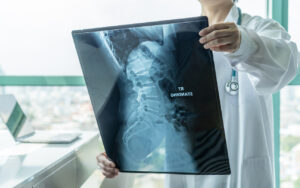Spinal Cord Injury

Spinal cord injuries have catastrophic effects. Severe injuries produce permanent paralysis. Less severe injuries can cause chronic pain, weakness, and mobility impairments. You may need physical therapy for the rest of your life, and even then, you might not regain any of the functions your injuries took from you.
As a result of these injuries, you might need to change jobs or quit working altogether. This could lead to significant financial hardships. You may lose the ability to participate in activities you enjoy, like sports, travel, and hobbies, reducing your quality and enjoyment of life.
The Anatomy of Your Spinal Cord

Your nervous system controls your entire body. Your brain gathers information through your sense organs and controls your body accordingly. When you exercise, for example, your brain instructs your body to release sugar to power your muscles and activates your sweat glands to cool your body.
Your spinal cord provides communication paths between your brain and body below your neck. A separate set of cranial nerves connects your brain to your head, face, and neck.
The spinal cord includes 31 pairs of spinal nerves. Each pair of spinal nerves branches into a corresponding pair of nerve roots at a vertebra. Thus, the number of spinal nerves remaining in the spinal cord drops as you move down the spine.
Each pair of nerve roots innervates your body’s left and right sides at a particular level. For example, a pair of spinal nerves that branches into nerve roots in your neck will innervate your shoulders. One of the pairs connects to your right shoulder, and the other connects to your left.
In addition to innervating muscles, your spinal nerves connect to several internal organs. The circulatory and digestive systems connect to one of your cranial nerves called the vagus nerve. But other organs like your liver, pancreas, kidneys, urine bladder, and reproductive organs connect to spinal nerves.
Most significantly, your spinal nerves control the diaphragm and chest muscles that enable respiration. Specifically, these muscles expand your chest, creating negative pressure in your lungs that causes air to rush into them as you inhale.
A spinal cord injury disrupts some or all of the nerve functions performed by the spinal cord. Importantly, an injury can disrupt signals in both directions, cutting off the sensations that control your body.
Spinal Cord Injury Causes
A spinal cord injury happens when one or more spinal nerves suffer damage.
This damage can take three forms:
- Laceration
- Traction
- Compression
A severed nerve cannot carry nerve signals. Lacerations do not heal, and doctors cannot repair this damage. As a result, lacerated spinal nerves produce permanent and total paralysis and loss of sensation in the body region served by them.
“Traction” is a pulling force on the nerves. “Compression” is a force that squeezes nerves, producing inflammation. When nerves stretch due to traction or inflame due to compression, they can misfire or drop nerve signals. Since the spinal nerves remain intact, your brain can still receive sensory signals and send motor signals, but they get scrambled in the transmission.
Up to 90% of spinal cord injuries result from trauma. Some common causes of spinal nerve damage include:
Blunt Force Injury
A blunt force injury to the spine can fracture a vertebra. A broken vertebra can dislocate into the spinal canal, where it stretches, compresses, or lacerates the spinal cord.
Falls can fracture a vertebra, particularly when the victim falls onto their back or head. For example, in a slip and fall accident, your feet slip forward, causing you to fall backward. The impact of your head and neck on the ground can fracture a vertebra and damage your spinal cord.
Penetrating Injury
Penetrating injuries happen when something pierces the spine. The foreign object lacerates, stretches, or compresses the spinal nerves. A penetrating injury can result from a deliberate assault with a gun or knife.
It can also result from unintentional trauma. You could fall onto a sharp object like a protruding nail or piece of rebar in a construction accident. It could also happen when you hit the ground in a motorcycle accident, falling onto a sharp piece of metal or glass.
Spinal Cord Injury Symptoms
The symptoms you experience when you suffer a spinal cord injury will depend on two factors: the completeness of the injury and the level of the injury.
A complete spinal cord injury happens when you sever the spinal nerves. You will permanently lose all sensation and movement below the level of the injury.
An incomplete spinal cord injury happens when you retain some movement and sensation after the injury. An incomplete injury might happen when you sever some spinal nerves while others remain intact. It can also happen when the spinal nerves get damaged by traction or compression without severing them.
The symptoms of an incomplete spinal cord injury may include:
- Pain
- Numbness or tingling
- Weakness
- Muscle spasms
- Loss of dexterity and fine motor control
Some accident victims with incomplete injuries recover some of their functions over time. Neuroplasticity refers to the brain’s ability to remap itself after an injury. Physical therapy helps the brain find a way to use the intact and undamaged nerves to control areas formerly controlled by damaged or severed nerves.
You have 24 vertebrae in your spine, including:
- Seven cervical vertebrae in your neck
- 12 thoracic vertebrae attached to your ribs
- Five lumbar vertebrae in your lower back
The level of the injury refers to the vertebra where the injury occurred. For example, a C5 injury refers to spinal cord damage at the fifth cervical vertebrae below your skull.
Since the spinal cord includes more spinal nerves higher in the spine, higher injuries will produce a greater loss of function. An injury at C1 or C2 immediately below the skull will often cause death. The spinal nerves at these levels control the diaphragm and chest muscles. When they get severed, the victim will stop breathing and will die within a few minutes without first aid.
A Baton Rouge Personal Injury Lawyer Can Help You Seek Compensation for a Spinal Cord Injury
You can pursue financial compensation for a spinal cord injury that was caused by someone else’s negligent or wrongful actions. If you successfully prove liability for your injury, you can pursue compensation for your economic and non-economic losses.
Economic losses include your past and future medical expenses and unearned income. Non-economic losses include the reduction in your quality of life due to pain, suffering, and disability.
When you suffer a spinal cord injury, you will likely have significant economic and non-economic losses. Contact one of our Palmintier Law Group lawyers for a free consultation with our Baton Rouge personal injury lawyers.
